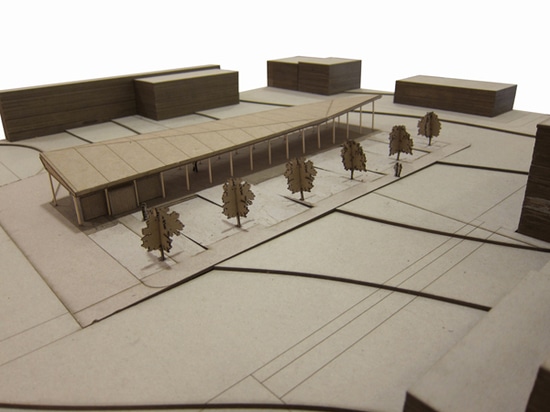
#COMMERCIAL ARCHITECTURE PROJECTS
Covington Farmers Market
In the United States, a growing number of architecture schools are integrating design-build programs, where students collaboratively design and construct a building to gain experience about how a building goes together and how ideas translate into reality.
A number of the programs follow the lead of the well known Rural Studio at Auburn University, led by the late Samuel Mockbee until 2001 and successor Andrew Freear since then. Marie and Keith Zawistowski, students of Mockbee, now head the design/buildLAB at Virginia Tech and instill that program with their mentor’s sense of social responsibility. The duo answered some questions about the design/buildLAB‘s most recently completed project.
What were the circumstances of receiving the commission for this project?
The design/buildLAB is a third year architecture studio at the Virginia Tech, School of Architecture + Design focused on the research, development and implementation of innovative construction methods and architectural designs. Students collaborate with local communities and experts to develop concepts and propose solutions to real world problems. The go1al of this course is to teach students the skills necessary to confront the design and realization of architecture projects, with a consciousness for social and environmental issues. By removing the abstraction from the making of architecture, the course engages students’ initiative and encourages them to ask fundamental questions about the nature of practice and the role of the architect.
The City of Covington is emblematic of many rural American factory towns struggling with little economic development. The Farmers Market was formed with no resources by a group enterprising Farmers. They had been operating on an open parking lot for some time but lacked a shelter and the means to realize one. The organization approached design/buildLAB for help. In addition to the design, administration and construction work, the design/buildLAB worked to secure funding for the project, including $119,000 grant from the Alleghany Foundation to cover material costs.
How does the completed building compare to the project as designed? Were there any dramatic changes between the two and/or lessons learned during construction?
One of the many challenges in design/build as a pedagogical model is that the students rarely have experience in building construction and thus don’t know what they don’t know. That is, they often think that a schematic level of design is ready for construction. This leads to many surprises on the jobsite as the student designer/builders scramble to resolve unconsidered conditions. In the case of the Covington Farmers Market Project the students were encouraged and guided to complete a set of highly detailed construction documents and specification prior to any building work. In this way, the project was realized largely as conceived, helping to ensure that the building would remain a durable, low maintenance asset of the community to which it was gifted.
How does the building compare to other projects in your office, be it the same or other building types?
The design/buildLAB is currently working toward the realization of an outdoor amphitheatre, stage and band shell in the town of Clifton Forge Virginia. This project, in an impoverished rail town, seeks to build on the successes of the Covington Farmers Market and to realize a building which is genuinely public and belongs to a broad cross section of the community. It will be similar is scale and scope to the Farmers Market. This building type will require the students to study other performance space: their programs, their infrastructure and equipment, and their acoustical performance. The students will collaborate with theater consultants and acousticians to ensure that this highly specialized building type is executed in a way that functions for the community.
How does the building relate to contemporary architectural trends, be it sustainability, technology, etc.?
Because all goods sold at this market are required to be produced within a 100-mile radius, this distance became a goal for the procurement of construction materials. Essential to this approach was the use of recycled building materials in the construction, in particular the re-use of wood salvaged from an old barn in a neighboring town. Additional, new lumber, including locust decking and yellow pine cladding for the project were sourced from locally sawn timbers.
Digital fabrication played a substantial role in the sustainability of the project by maximizing structural efficiency and minimizing waste.
In terms of limiting water and energy use, the project incorporates a rain water collection system, LED lighting and natural ventilation. A 1,200-gallon cistern collects water from the roof and is used for watering the park and flushing toilets. LED lighting ensures long bulb life and extremely low energy consumption. Further, the pavilion roof was designed with an inverted ceiling to facilitate stack effect ventilation and eliminate the need for mechanical cooling.
Finally, the asphalt surface from the site’s previous parking lot was milled and stored through construction to be repurposed as a new permeable, compacted, parking area.





